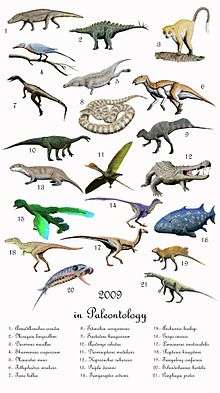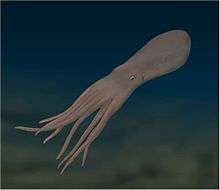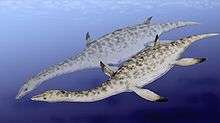2009 in paleontology
| |||
|---|---|---|---|
| Wikimedia Commons has media related to 2009 in paleontology. |

Paleontology or palaeontology (from Greek: paleo, "ancient"; ontos, "being"; and logos, "knowledge") is the study of prehistoric life forms on Earth through the examination of plant and animal fossils.[1] This includes the study of body fossils, tracks (ichnites), burrows, cast-off parts, fossilised feces (coprolites), palynomorphs and chemical residues. Because humans have encountered fossils for millennia, paleontology has a long history both before and after becoming formalized as a science. This article records significant discoveries and events related to paleontology that occurred or were published in the year 2009.
Arthropods
Cephalopods
Three new species of extinct Octopoda discovered in 2009. The species – Keuppia hyperbolaris, Keuppia levante, and Styletoctopus annae – lived about 95 million years ago, and bear a strong resemblance to modern octopuses, suggesting that the Octopoda order has remained relatively unchanged for tens of millions of years. The fossils included evidence of arms, muscles, rows of suckers, ink, and internal gills. The discovery was made by a team led by Dirk Fuchs of the Freie University, which is located at Berlin, Germany.[2] The fossils were found at Hakel and Hadjoula, Lebanon.[3] Various new ammonoid taxa were named, including Ivoites.
| Name | Novelty | Status | Authors | Age | Unit | Location | Notes | Images |
|---|---|---|---|---|---|---|---|---|
|
Gen et sp nov |
Valid |
Fuchs, Bracchi, & Weis |
Upper Cenomanian |
| ||||
|
gen et sp nov |
Valid |
Fuchs, Bracchi, & Weis |
Upper Cenomanian |
|||||
|
Ivoites[5] |
gen nov |
Valid |
De Baets, Klug, & Korn |
Lower Emsian |
||||
Bony fish
| Newly named Tetrapodomoprhs | |||||||
|---|---|---|---|---|---|---|---|
| Name | Status | Authors | Age | Unit | Location | Notes | Images |
| Aphanius yerevanicus[6] |
Valid |
|
Late Miocene |
A pupfish, a species of Aphanius. | |||
| Eophryne[7] |
Valid |
|
Eocene (late Ypresian) |
Monte Bolca locality |
A frogfish. The type species is Eophryne barbutii. | ||
| Heddleichthys[8] |
Valid |
|
Famennian (Late Devonian) |
Dura Den Formation |
|||
| Hendrixella[9] |
Valid |
|
Eocene (late Ypresian) |
Monte Bolca locality |
A member of Percoidei of uncertain phylogenetic placement. The type species is Hendrixella grandei. | ||
| Langlieria[10] |
Valid |
|
Famennian (Late Devonian) |
Evieux Formation |
|||
- Shimada, K.; Everhart, M.J. (2009). "First record of Anomoeodus (Osteichthyes: Pycnodontiformes) from the Upper Cretaceous Niobrara Chalk of western Kansas". Transactions of the Kansas Academy of Science. 112 (1/2): 98–102. doi:10.1660/062.112.0212.
A new species of late Maastrichtian bony fish (Ichthyodectiformes: Saurocephalus) from Jordan, Saurocephalus longicorpus described by Kaddumi (2009)
A new species of late Maastrichtian bony fish (Aulopiformes: Enchodontidae) from Jordan, Enchodus harranaensis described by Kaddumi (2009)
Reference: Kaddumi, H. F. 2009. Fossils of the Harrana Fauna and the Adjacent Areas. Publications of the Etrnal Rive Museum of Natural History, Amman. 324 pp.
Amphibians
Newly named amphibians
| Name | Status | Authors | Age | Unit | Location | Notes | Images |
|---|---|---|---|---|---|---|---|
|
Valid |
|
Lower Cretaceous |
Possible stem neobatrachian |
||||
|
Valid |
|
Lower Cretaceous |
A hyloid | ||||
|
Valid |
|
Early Permian |
The smallest known ostodolepid microsaur | ||||
|
Valid |
|
Turonian |
|||||
|
Valid |
|
Early Cretaceous |
A cryptobranchoid salamander | ||||
|
Valid |
|
Early Permian |
|||||
Basal reptiles
Newly named basal reptiles
| Name | Status | Authors | Discovery year | Age | Unit | Location | Notes | Images |
|---|---|---|---|---|---|---|---|---|
|
Valid |
|
Middle Permian |
A basal parareptile | |||||
|
Valid |
|
early Late Olenekian |
Czatkowice 1 |
|||||
Turtles
Newly named turtles
| Name | Status | Authors | Discovery year | Age | Unit | Location | Notes | Images |
|---|---|---|---|---|---|---|---|---|
|
Valid |
|
Turonian (Late Cretaceous) |
||||||
|
Valid |
|
Late Cretaceous |
||||||
|
Valid |
|
Late Jurassic/Lower Cretaceous |
||||||
|
Valid |
|
Paleocene |
|
New genus for "Plesiobaena" putorius Gaffney, 1972 | ||||
|
Chelonoidis alburyorum[22] |
Valid |
|
Holocene |
A tortoise. | ||||
|
Junior synonym |
|
Early Paleocene |
|
Junior synonym of Hutchemys.[24] | ||||
|
Valid |
|
Middle Jurassic |
||||||
|
Valid |
|
Paleocene |
|
A plastomenine softshell turtles | ||||
|
Valid |
Late Cretaceous |
|||||||
|
Valid |
|
Maastrichtian |
|
A baenid | ||||
|
Valid |
|
Late Cretaceous |
|
A baenid | ||||
|
Junior synonym |
|
Early Paleocene |
|
Junior synonym of Hutchemys.[24] | ||||
Archosauromorphs
Basal archosauromorphs
| Newly named basal archosauromorphs | |||||||
|---|---|---|---|---|---|---|---|
| Name | Status | Authors | Age | Unit | Location | Notes | Images |
|
Valid |
|
earliest Late Olenekian |
Czatkowice 1 |
A long−necked archosauromorph |
|||
Archosaurs
Lepidosauromorphs
Basal lepidosauromorphs
| Newly named basal lepidosauromorphs | |||||||
|---|---|---|---|---|---|---|---|
| Name | Status | Authors | Age | Unit | Location | Notes | Images |
|
Valid |
Early Olenekian |
Czatkowice 1 |
A basal kuehneosaurid |
||||
|
Valid |
|
earliest Late Olenekian |
Czatkowice 1 |
A basal lepidosauromorph | |||
Plesiosaurs
- In 2009, in Svalbard, Norway a new pliosaur was found by Jorn Hurum. It currently is codenamed as "Predator X."
- O'Keefe, F. R.; Street, H. P. (2009). "Osteology of the cryptocleidoid plesiosaur Tatenectes laramiensis, with comments on the taxonomic status of the Cimoliasauridae". Journal of Vertebrate Paleontology. 29 (1): 48–57. doi:10.1671/039.029.0118.
| Newly named plesiosaurs | |||||||
|---|---|---|---|---|---|---|---|
| Name | Status | Authors | Age | Unit | Location | Notes | Images |
|
Valid |
|
Late Jurassic (Oxfordian) |
|||||
|
Valid |
|
Early Cretaceous (Albian) |
Replacement name for Nichollsia Druckenmiller & Russell, 2008, preoccupied by an isopod genus Nichollsia Chopra & Tiwari, 1950 |
| |||
Squamates
| Newly named squamates | |||||
|---|---|---|---|---|---|
| Name | Status | Authors | Notes | Images | |
| Titanoboa[34] | Valid |
|
|
In February, the fossils of 28 individual T. cerrejonensis (Titanoboas) were announced to have been found in the coal mines of Cerrejón, La Guajira, Colombia.[35] |
|
Synapsids
Non-mammalian
| Name | Status | Authors | Age | Unit | Location | Notes | Images |
|---|---|---|---|---|---|---|---|
|
Valid |
|
Middle Triassic (Ladinian) |
|||||
|
Valid |
|
Middle Permian (Roadian) |
| ||||
|
Valid |
|
Late Jurassic (Oxfordian) |
Mammals
Plants
Angiosperms
| Name | Novelty | Status | Authors | Age | Unit | Location | Notes | Images |
|---|---|---|---|---|---|---|---|---|
|
Eucalyptolaurus[39] |
gen et sp nov |
Valid |
Coiffard et al. |
uppermost Albian-lowermost Cenomanian |
Charente-Maritimes |
|||
Relevant research in other sciences
Evolutionary biology
- A study is published that proposes that females from certain taxa use ornaments as a criterion for mate choice because other dimorphic structures, like biological "weaponry" could be used to coerce or force them to mate.[40]
- A study concludes that biotic factors have more pronounced local and short term evolutionary impacts than abiotic factors, which in turn have a more pronounced effect through time and on biodiversity as a whole.[41]
Extinction
A study noting the effects of the KT mass extinction on Earth's modern biota is published.[42]
Geology
- Zhang, H.; Wei, Z.-L.; Liu, X.-M.; Li, D. (2009). "Constraints on the age of the Tuchengzi Formation by LA-ICP-MS dating in northern Hebei-western Liaoning, China". Science China Earth Sciences. 52 (4): 461–470. doi:10.1007/s11430-009-0052-9.
Ichnology
- Bedatou, E., Melchor, R.N., and Genise, J.F. 2009. Complex palaeosol ichnofabrics from Late Jurassic-Early Cretaceous volcaniclastic successions of central Patagonia, Argentina. Sedimentary Geology. doi:10.1016/j.sedgeo.2009.04.005
Paleobiogeography
- Pereda-Suberbiola, X. 2009. Biogeographical affinities of Late Cretaceous
continental tetrapods of Europe: a review. Bulletin de la Société Géologique de France 180(1):57-71. doi:10.2113/gssgfbull.180.1.57.
Paleoecology
- Nicolas, M., and Rubidge, B.S. 2009. Changes in Permo-Triassic terrestrial tetrapod ecological representation in the Beaufort Group (Karoo Supergroup) of South Africa. Lethaia. doi:10.1111/j.1502-3931.2009.00171.x.
Footnotes
Complete author list
As science becomes more collaborative, papers with large numbers of authors are becoming more common. To prevent the deformation of the tables, these footnotes list the contributors to papers that erect new genera and have many authors.
References
- ↑ Gini-Newman, Garfield; Graham, Elizabeth (2001). Echoes from the past: world history to the 16th century. Toronto: McGraw-Hill Ryerson Ltd. ISBN 9780070887398. OCLC 46769716.
- ↑ Rare fossil octopuses found, MSNBC, March 18, 2009
- ↑ New Octopus from the late Cretaceous of Hakel and Hadjoula, Lebanon, Palaeontology, Volume 52, Issue 1, Pages 65-81
- 1 2 Fuchs, D.; Bracchi, G.; Weis, R. (2009). "New Octopods (Cephalopoda: Coleoidea) from the Late Cretaceous (Upper Cenomanian) of Hakel and Hadjoula, Lebanon". Palaeontology. 52 (1): 65–81. doi:10.1111/j.1475-4983.2008.00828.x. Retrieved 24 March 2010.
- ↑ De Baets, K.; Klug, C.; Korn, D. (2009). "Anetoceratinae (Ammonoidea, Early Devonian) from the Eifel and Harz Mountains (Germany), with a revision of their genera". Palaeontology. 252 (3): 361–376. doi:10.1127/0077-7749/2009/0252-0361. Retrieved 24 March 2010.
- ↑ Davit Vasilyan; Bettina Reichenbacher; Giorgio Carnevale (2009). "A new fossil Aphanius species from the Upper Miocene of Armenia (Eastern Paratethys)". Paläontologische Zeitschrift. 83 (4): 511–519. doi:10.1007/s12542-009-0034-4.
- ↑ Giorgio Carnevale; Theodore W. Pietsch (2009). "An Eocene frogfish from Monte Bolca, Italy: the earliest known skeletal record for the family". Palaeontology. 52 (4): 745–752. doi:10.1111/j.1475-4983.2009.00874.x.
- ↑ Snitting, D. (2009). "Heddleichthys- a new tristichopterid genus from the Dura Den Formation, Midland Valley, Scotland (Famennian, Late Devonian)". Acta Zoologica. 90: 273. doi:10.1111/j.1463-6395.2008.00376.x.
- ↑ Alexandre F. Bannikov; Giorgio Carnevale (2009). "A new percoid fish from the Eocene of Monte Bolca, Italy: Hendrixella grandei gen. & sp. nov.". Swiss Journal of Geosciences. 102 (3): 481–488. doi:10.1007/s00015-009-1331-3.
- ↑ Clément, G; Snitting, D; Ahlberg, PE; Gaël Clément; Daniel Snitting; Per Erik Ahlberg (July 2009). "A new Tristichopterid (Sarcopterygii, Tetrapodomorpha) from the Evieux Formation (Upper Devonian) of Belgium". Palaeontology. 52 (4): 823–836. doi:10.1111/j.1475-4983.2009.00876.x.
- 1 2 Báez, Ana M.; Moura, Geraldo J.B.; Gómez, Raúl O.; Ana M. Báez; Geraldo J.B. Moura; Raúl O. Gómez (2009). "Anurans from the Lower Cretaceous Crato Formation of northeastern Brazil: implications for the early divergence of neobatrachians". Cretaceous Research. 30 (4): 829–846. doi:10.1016/j.cretres.2009.01.002.
- ↑ Anderson, J.S.; Scott, D.; Reisz, R.R. (2009). "Nannaroter mckinziei, a new ostodolepid 'microsaur' (Tetrapoda, Lepospondyli, Recumbirostra) from the Early Permian of Richards Spur (Ft. Sill), Oklahoma". Journal of Vertebrate Paleontology. 29 (2): 379–388. doi:10.1671/039.029.0222.
- ↑ Skutschas, Pavel P.; Pavel P. Skutschas (2009). "Re-Evaluation of Mynbulakia Nesov, 1981 (Lissamphibia: Caudata) and Description of a New Salamander Genus from the Late Cretaceous of Uzbekistan". Journal of Vertebrate Paleontology. 29 (3): 659–664. doi:10.1671/039.029.0326. Retrieved 16 August 2010.
- ↑ Zhang, Guilin; Wang, Yuan; Jones, Marc E.H.; Evans, Susan E.; Guilin Zhang; Yuan Wang; Marc E.H. Jones; Susan E. Evans (2009). "A new Early Cretaceous salamander (Regalerpeton weichangensis gen. et sp. nov.) from the Huajiying Formation of northeastern China". Cretaceous Research. 30 (3): 551–558. doi:10.1016/j.cretres.2008.10.004. Retrieved 16 August 2010.
- ↑ Klembara, Jozef (2009). "The skeletal anatomy and relationships of a new discosauriscid seymouriamorph from the lower Permian of Moravia (Czech Republic)". Annals of Carnegie Museum. 77 (4): 451–483. doi:10.2992/0097-4463-77.4.451.
- ↑ Sean P. Modesto; Diane M. Scott; Robert R. Reisz (2009). "A new parareptile with temporal fenestration from the Middle Permian of South Africa". Canadian Journal of Earth Sciences. 46 (1): 9–20. Bibcode:2009CaJES..46....9M. doi:10.1139/E09-001. Retrieved 14 August 2010.
- ↑ Magdalena Borsuk−Białynicka; Mariusz Lubka (2009). "Procolophonids from the Early Triassic of Poland" (PDF). Paleontologica Polonica. 65: 107–144. Retrieved 12 August 2010..
- ↑ Octávio Mateus; Louis Jacobs; Michael Polcyn; Anne S. Schulp; Diana Vineyard; André Buta Neto; Miguel Telles Antunes (2009). "The oldest African eucryptodiran turtle from the Cretaceous of Angola" (PDF). Acta Palaeontologica Polonica. 54 (4): 581–588. doi:10.4202/app.2008.0063. Retrieved 21 June 2010.
- ↑ Vandermark, D.; Tarduno, J.A.; Brinkman, D.B.; Cottrell, R.D.; Mason, S. (2009). "New Late Cretaceous macrobaenid turtle with Asian affinities from the High Canadian Arctic: dispersal via ice-free polar routes". Geology. 37 (2): 183–186. Bibcode:2009Geo....37..183V. doi:10.1130/G25415A.1.
- ↑ Tong, H.; Claude, J.; Naksri, W.; Suteethorn, V.; Buffetaut, E.; Khansubha, S.; Wongko, K. & Yuangdetkla, P. (2009). "Basilochelys macrobios n. gen. and n. sp., a large cryptodiran turtle from the Phu Kradung Formation (latest Jurassic-earliest Cretaceous) of the Khorat Plateau, NE Thailand". In: Buffetaut, E.; Cuny, G.; Le Loeuff, J. & Suteethorn, V. (eds.). Late Palaeozoic and Mesozoic Ecosystems in SE Asia. Geological Society, London, Special Publications 315: 229-243.
- 1 2 Lyson, T.R.; Joyce, W.G. (2009). "A revision of Plesiobaena (Testudinoes: Baenidae) and an assessment of Baenid ecology across the K/T boundary". Journal of Paleontology. 83 (6): 833–853. doi:10.1666/09-035.1.
- ↑ Richard Franz; Shelley E. Franz (2009). "A new fossil land tortoise in the genus Chelonoidis (Testudines: Testudinidae) from the northern Bahamas, with an osteological assessment of other Neotropical tortoises". Bulletin of the Florida Museum of Natural History. 49 (1): 1–44.
- 1 2 John Howard Hutchison (2009). "New soft-shelled turtles (Plastomeninae, Trionychidae, Testudines) from the Late Cretaceous and Paleocene of North America". PaleoBios. 29 (2): 36–47. Retrieved 7 August 2010.
- 1 2 Walter G. Joyce; Tyler R. Lyson (2011). "New Material of Gilmoremys lancensis nov. comb. (Testudines: Trionychidae) from the Hell Creek Formation and the Diagnosis of Plastomenid Turtles". Journal of Paleontology. 85 (3): 442–459. doi:10.1666/10-127.1.
- ↑ Anquetin, J.; Barrett, P.M.; Jones, M.E.H.; Moore-Fay, S.; Evans, S.E. (2009). "A new stem turtle from the Middle Jurassic of Scotland: new insights into the evolution and palaeoecology of basal turtles". Proceedings of the Royal Society B. 276 (1658): 879–886. doi:10.1098/rspb.2008.1429. PMC 2664364
 . PMID 19019789..
. PMID 19019789.. - ↑ Walter G. Joyce; Ariel Revan; Tyler R. Lyson; Igor G. Danilov (2009). "Two New Plastomenine Softshell Turtles from the Paleocene of Montana and Wyoming" (PDF). Bulletin of the Peabody Museum of Natural History. 50 (2): 307–325. doi:10.3374/014.050.0202. Retrieved 7 August 2010.
- ↑ Gaffney, E.S.; Krause, D.W.; Zalmout, I.S. (2009). "Kinkonychelys, a new side-necked turtle (Pelomedusoides: Bothremydidae) from the Late Cretaceous of Madagascar". American Museum Novitates. 3662: 1–25. doi:10.1206/672.1.
- ↑ Lyson, T.R.; Joyce, W.G. (2009). "A New Species of Palatobaena (Testudines: Baenidae) and a Maximum Parsimony and Bayesian Phylogenetic Analysis of Baenidae". Journal of Paleontology. 83 (3): 457–470. doi:10.1666/08-172.1. Retrieved 17 August 2010.
- ↑ Magdalena Borsuk−Białynicka; Susan E. Evans (2009). "A long−necked archosauromorph from the Early Triassic of Poland" (PDF). Paleontologica Polonica. 65: 203–234. Retrieved 17 August 2010.
- ↑ Susan E. Evans (2009). "An early kuehneosaurid reptile (Reptilia: Diapsida) from the Early Triassic of Poland" (PDF). Paleontologica Polonica. 65: 145–178. Retrieved 13 August 2010.
- ↑ Susan E. Evans; Magdalena Borsuk−Białynicka (2009). "A small lepidosauromorph reptile from the Early Triassic of Poland" (PDF). Paleontologica Polonica. 65: 179–202. Retrieved 13 August 2010.
- ↑ Gasparini, Z. (2009). "A New Oxfordian Pliosaurid (Plesiosauria, Pliosauridae) in the Caribbean Seaway". Palaeontology. 52 (3): 661–669. doi:10.1111/j.1475-4983.2009.00871.x.
- ↑ Druckenmiller, P.S.; Russell, A.P. (2009). "The new plesiosaurian genus Nichollssaura from Alberta, Canada: replacement name for the preoccupied genus Nichollsia". Journal of Vertebrate Paleontology. 29 (1): 276. doi:10.1080/02724634.2009.10010379.
- ↑ Head, Jason J.; Jonathan I. Bloch; Alexander K. Hastings; Jason R. Bourque; Edwin A. Cadena; Fabiany A. Herrera; P. David Polly; Carlos A. Jaramillo (2009). "Giant boid snake from the paleocene neotropics reveals hotter past equatorial temperatures". Nature. 457 (7230): 715–718. Bibcode:2009Natur.457..715H. doi:10.1038/nature07671. PMID 19194448. Archived from the original on 8 February 2009. Retrieved 2009-02-05.
- ↑ Kwok, Roberta (4 February 2009). "Scientists find world's biggest snake". Nature. Archived from the original on 6 February 2009. Retrieved 2009-02-04.
- ↑ Reichel, M.; Schultz, C.L.; Soares, M.B. (2009). "A new traversodontid cynodont (Therapsida, Eucynodontia) from the Middle Triassic Santa Maria Formation of Rio Grande do Sul, Brazil". Palaeontology. 52 (1): 229–250. doi:10.1111/j.1475-4983.2008.00824.x.
- ↑ Liu, J.; Rubidge, B.; Li, J. (2009). "New basal synapsid supports Laurasian origin for therapsids". Acta Palaeontologica Polonica. 54 (3): 393–400. doi:10.4202/app.2008.0071.
- ↑ Hu, Y.; Meng, J.; Clark, J.M. (2009). "A new tritylodontid from the Upper Jurassic of Xinjiang, China". Acta Palaeontologica Polonica. 54 (3): 385–391. doi:10.4202/app.2008.0053.
- ↑ Coiffard, C; Gomez, B; Thiébaut, M; Kvácek, J; Thévenard, F; Néraudeau, D (2009). "Intramarginal veined Lauraceae Leaves from the Albian-Cenomanian of Charente-Maritime (western France)". Palaeontology. 52 (2): 323–336. doi:10.1111/j.1475-4983.2009.00845.x.
- ↑ Pradhan, G.R.; Van Schaik, C.P. (2009). "Why do females find ornaments attractive? The coercion-avoidance hypothesis". Biological Journal of the Linnean Society. 96 (2): 372–382. doi:10.1111/j.1095-8312.2008.01131.x.
- ↑ Benton, M.J. (2009). "The Red Queen and the Court Jester: species diversity and the role of biotic and abiotic factors through time". Science. 323 (5915): 728–732. Bibcode:2009Sci...323..728B. doi:10.1126/science.1157719. PMID 19197051.
- ↑ Krug, A.Z.; Jablonski, D.; Valentine, J.W. (2009). "Signature of the end-Cretaceous mass extinction in the modern biota". Science. 323 (5915): 767–771. Bibcode:2009Sci...323..767K. doi:10.1126/science.1164905. PMID 19197060.


